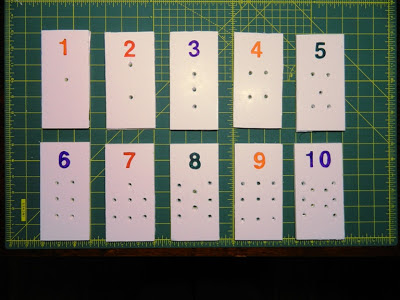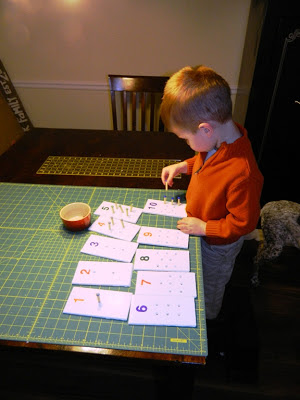 |
Samuel has been very interested in numbers. After talking with some of our followers on our Facebook group, I understand that many parents have children with the same beginning interests as Sam. I looked up buying a peg board game but the price seemed a little steep for the product. So as a Mom on a budget, I set out to make something that would be just as useful for the introduction of numbers to my little guy. I ended up with a comparable activity for $12.50 (in 2013 when I first wrote this post).
"Man's mind was mathematical by nature and that knowledge and progress came from accurate observation." ~from Maria Montessori via Blaise Pascal in The Absorbent Mind
The greatest thing about the Montessori Method is taking cues from your child about where their learning is going. This peg board game is an introduction to numbers and can be used before using the Number Rods or Spindle Boxes for beginning mathematics. I want to be able to tap into Samuel's innate need to learn numbers so I'm going to try to present as many activities as I can to help him learn his numbers, counting, and beginning mathematics.
 |
| Photos by Marie Mack |
On Sunday after church, I stopped by the local Michael's craft store. I knew what my end product should look like, but didn't really have any materials in mind when I started my shopping. I found at Michael's a piece of Foam Board, a set of stencils that I know I will use for many other projects and some small wooden pegs. When I got home I raided my craft boxes. I found leftover paint, a paintbrush, markers, scissors, a hole punch, and cutting boards. After working on my project, I found that a rotatory cutter worked much better than scissors and the end of a pair of needle nose pliers worked better than my hole punch.
 |
| Photo by Marie Mack |
I wanted to make a set of boards like the ones I saw peg boards I wanted to buy on an online Montessori seller. I decided to make my boards 3 inches by 6 inches. This allowed me to use only half of my foam board. (Leftover foam board for another project: Bonus!)
 |
| Photo by Marie Mack |
 |
| Photo by Marie Mack |
 |
| Photo by Marie Mack |
 |
| Photo by Marie Mack |
After I finished my numbers, I measured the center of the boards to align the holes. I made a mark with my pencil to be sure my end product would look the way I wanted it to. Then I used the end of my needle-nosed pliers to push through the foam board to make a small hole. I did the same thing on the opposite side. Once I had a hole all the way through, I pushed one of the wooden pegs through the board to be sure the hole was large enough. I cleaned up the back of the holes with some scissors.
 |
| Photo by Marie Mack |
Here are my end products. I chose not to create a board with the number 0 on it. It seems like an abstract concept for my son who is in a concrete mind. I won't have any problem putting together a board for 0 once I feel like he has a firm grasp on these beginning numbers. If you would like an activity on the number zero, I found a VERY simple one here.
 |
| Photo by Marie Mack |
 |
| Photo by Marie Mack |
Before I had a chance to present this product to Samuel, he snuck into the dining room where our project was and started exploring our new activity. I love his enthusiasm and was happy to let him work with the boards.
If you are not familiar with giving a three-part lesson, please see Lisa's post here. This is a very easy way to present activities and you will use this method throughout your time using the Montessori Method.
 |
| Photo by Marie Mack |
Presenting this activity is very easy. Have your child roll out his mat and set out the activity. Show how each peg is placed into the holes. Reiterate the fact that one peg is on the board for the numeral one. Make the same comparison for other boards.
Additionally, you can count the pegs with your child as they place them in the holes. Samuel also liked having the same color pegs for one number. For example, all five red pegs were placed on the number five board or two green pegs on the number two board. This is another sorting activity for your child.
Allowing children to see the concept of what the number one looks like is a concrete concept which Montessori stresses is the first step to understanding such an abstract idea as numbers. The human mind creates order in the first plane of development. (Please see page 33 of The Four Planes of Development by Camillo Grazzini.) The conscious-worker sensitive period is where Samuel is now. I hope to capitalize on this natural progression of "constructive perfectionment" of the human mind by introducing him to numbers in the most concrete way I can.
This is one of many great activities out there for an introduction to numbers and counting. Lisa has created a wonderful program designed to help you with all these toddler and preschool activities. She has set up pre-made lesson plans, and colored pictures, and offers personal advice on your specific situation. We used her online Montessori program with Samuel and it helped so much as a new Montessori family. ~Marie Mack (This post was originally published at Montessori on a Budget.)
